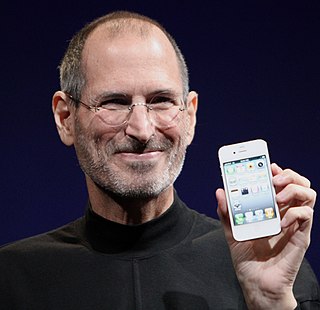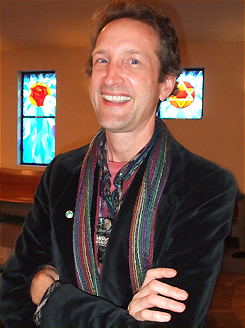Related Research Articles

Stephen Gary Wozniak, also known by his nickname Woz, is an American technology entrepreneur, electrical engineer, computer programmer, philanthropist, and inventor. In 1976, he co-founded Apple Computer with his early business partner Steve Jobs. Through his work at Apple in the 1970s and 1980s, he is widely recognized as one of the most prominent pioneers of the personal computer revolution.

Lisa is a desktop computer developed by Apple, produced from January 19, 1983 to August 1, 1986, and succeeded by Macintosh. It is generally considered the first mass-market personal computer operable through a graphical user interface (GUI). In 1983, a machine like the Lisa was still so expensive that it was primarily marketed to individual and small and medium-sized businesses as a groundbreaking new alternative to much bigger and more expensive mainframes or minicomputers such as from IBM, that either require additional, expensive consultancy from the supplier, hiring specially trained personnel, or at least, a much steeper learning curve to maintain and operate. Earlier GUI-controlled personal computers were not mass-marketed; for example, Xerox PARC manufactured its Alto workstation only for Xerox and select partners from the early to mid-1970s.

Jef Raskin was an American human–computer interface expert who conceived and began leading the Macintosh project at Apple in the late 1970s.

John Sculley III is an American businessman, entrepreneur and investor in high-tech startups. Sculley was vice-president (1970–1977) and president of PepsiCo (1977–1983), until he became chief executive officer (CEO) of Apple Inc. on April 8, 1983, a position he held until leaving on October 15, 1993. In 1987, Sculley was named Silicon Valley's top-paid executive, with an annual salary of US$10.2 million.

Pirates of Silicon Valley is a 1999 American biographical drama television film directed by Martyn Burke and starring Noah Wyle as Steve Jobs and Anthony Michael Hall as Bill Gates. Spanning the years 1971–1997 and based on Paul Freiberger and Michael Swaine's 1984 book Fire in the Valley: The Making of the Personal Computer, it explores the impact that the rivalry between Jobs and Gates (Microsoft) had on the development of the personal computer. The film premiered on TNT on June 20, 1999.

Andrew Jay Hertzfeld is an American software engineer who was a member of Apple Computer's original Macintosh development team during the 1980s. After buying an Apple II in January 1978, he went to work for Apple Computer from August 1979 until March 1984, where he was a designer for the Macintosh system software.

The Macintosh, later rebranded as the Macintosh 128K, is the original Macintosh personal computer from Apple. It is the first successful mass-market all-in-one desktop personal computer with a graphical user interface, built-in screen and mouse. It was pivotal in establishing desktop publishing as a general office function. The motherboard, a 9 in (23 cm) CRT monochrome monitor, and a floppy drive are in a beige case with integrated carrying handle; it has a keyboard and single-button mouse.
Burrell Carver Smith is a retired American computer engineer who created the first wire wrap prototype of the motherboard for the original Macintosh at Apple Computer. He became Apple employee #282 in February 1979 as an Apple II service technician. He designed the motherboard for Apple's LaserWriter.
Reality distortion field (RDF) is a term first used by Bud Tribble at Apple Computer in 1981, to describe company co-founder Steve Jobs's charisma and its effects on the developers working on the Macintosh project. Tribble said that the term came from the Star Trek episode "The Menagerie", in which it is used to describe how the aliens encountered by the crew of the starship Enterprise created their own new world through mental force.
Armas Clifford "Mike" Markkula Jr. is an American electrical engineer, businessman and investor. He was the original angel investor, first chairman, and second CEO for Apple Computer, Inc., providing critical early funding and managerial support. At the company's incorporation, Markkula owned 26% of Apple, equivalent to each of the shares owned by cofounders Steve Jobs and Steve Wozniak.
Guy L. "Bud" Tribble is a software technologist known for his work on the original Apple Macintosh.
Steve Capps is a pioneering American computer programmer and software engineer, who was one of the original designers of the Apple Macintosh computer and co-designers of the Finder in the 1980s. He also led development of the Apple Newton PDA and designed music software such as SoundEdit, before developing user interface (UI) designs for Microsoft's Internet Explorer and online/mobile payment systems.

Apple Inc., originally Apple Computer, Inc., is a multinational corporation that creates and markets consumer electronics and attendant computer software, and is a digital distributor of media content. Apple's core product lines are the iPhone smartphone, iPad tablet computer, and the Mac personal computer. The company offers its products online and has a chain of retail stores known as Apple Stores. Founders Steve Jobs, Steve Wozniak, and Ronald Wayne created Apple Computer Co. on April 1, 1976, to market Wozniak's Apple I desktop computer, and Jobs and Wozniak incorporated the company on January 3, 1977, in Cupertino, California.
Joanna Karine Hoffman is a Polish-American marketing executive. She was one of the original members of both the Apple Macintosh team and the NeXT team.

Steven Paul Jobs was an American businessman, inventor, and investor best known for co-founding the technology company Apple Inc. Jobs was also the founder of NeXT and chairman and majority shareholder of Pixar. He was a pioneer of the personal computer revolution of the 1970s and 1980s, along with his early business partner and fellow Apple co-founder Steve Wozniak.

Daniel Kottke is an American businessman known for having been a college friend of Steve Jobs and one of the first employees of Apple Inc. He met Jobs at Reed College in 1972, and they trekked together through India for spiritual enlightenment and to the All One Farm. In 1976, Kottke realized his interest in computers when Jobs hired him to assemble hobbyist computer projects and then to be a part-time employee at the newly founded Apple Computer. There, he debugged the Apple II family, prototyped the Apple III and Macintosh, and endured the IPO where Steve Wozniak assigned Kottke some of his own stock. He was portrayed in several films about Apple.

Mac, short for Macintosh, is a family of personal computers designed and marketed by Apple. The name Macintosh is a reference to a type of apple called McIntosh. The product lineup includes the MacBook Air and MacBook Pro laptops, and the iMac, Mac Mini, Mac Studio, and Mac Pro desktops. Macs are sold with the macOS operating system; the latest release is macOS 15 Sequoia.
MacBASIC was a programming language and interactive environment designed by Apple Computer for the original Macintosh computer. It was developed onn Denman, with help from fellow Apple programmers Marianne Hsiung, Larry Kenyon, and Bryan Stearns, as part of the original Macintosh development effort starting in late 1981. Andy Hertzfeld said, "A BASIC interpreter would be important, to allow users to write their own programs. We decided we should write it ourselves, instead of relying on a third party, because it was important for the BASIC programs to be able to take advantage of the Macintosh UI, and we didn't trust a third party to 'get it' enough to do it right."

Jobs is a 2013 American biographical drama film based on the life of Steve Jobs, from 1974 while a student at Reed College to the introduction of the iPod in 2001. It is directed by Joshua Michael Stern, written by Matt Whiteley, and produced by Stern and Mark Hulme. Steve Jobs is portrayed by Ashton Kutcher, with Josh Gad as Apple Computer's co-founder Steve Wozniak. Jobs was chosen to close the 2013 Sundance Film Festival.

Revolution in the Valley: The Insanely Great Story of How the Mac Was Made is a nonfiction book written by Andy Hertzfeld about the birth of the Apple Macintosh personal computer. The author was a core member of the team that built the Macintosh system software and the chief creator of the Mac's radical new user interface software. The book is a collection of anecdotes tracing the development of the Macintosh from a secret project in 1979 through its "triumphant introduction" in 1984. These anecdotes were originally published on the author's Folklore.org web site.
References
- ↑ Isaacson, Walter (2011). Steve Jobs .
[Mike] Markkula [born February 11, 1942] and Scott...shared the same birthday, which they celebrated together each year. At their birthday lunch in February 1977, when Scott was turning thirty-two...
- ↑ Berlin, Leslie (2017). Troublemakers : Silicon Valley's Coming of Age (1st ed.). New York. p. 50. ISBN 978-1-4516-5150-8. OCLC 1008569018. Archived from the original on May 3, 2024. Retrieved May 4, 2022.
{{cite book}}: CS1 maint: location missing publisher (link) - ↑ Hertzfeld, Andy (October 1980). "Macintosh stories: Good Earth". Folklore.org. Archived from the original on November 17, 2016. Retrieved June 15, 2017.
- ↑ Hertzfeld, Andy (February 1981). "Macintosh stories: Black Wednesday". Folklore.org. Archived from the original on June 20, 2019. Retrieved June 15, 2017.
- ↑ Seibold, Chris (July 10, 2011). "July 10, 1981: Michael Scott Leaves Apple". AppleMatters.com. Archived from the original on March 12, 2018. Retrieved March 12, 2018.
- ↑ Linzmayer, pg 17
- ↑ "Sponsor and contributors (Michael Scott)". Archived from the original on May 28, 2019. Retrieved August 21, 2006.
- ↑ "Rruffite". Mindat.org. Archived from the original on December 22, 2011. Retrieved March 10, 2012.
- ↑ "Scottyite". Mindat.org. Archived from the original on July 30, 2017. Retrieved August 31, 2012.